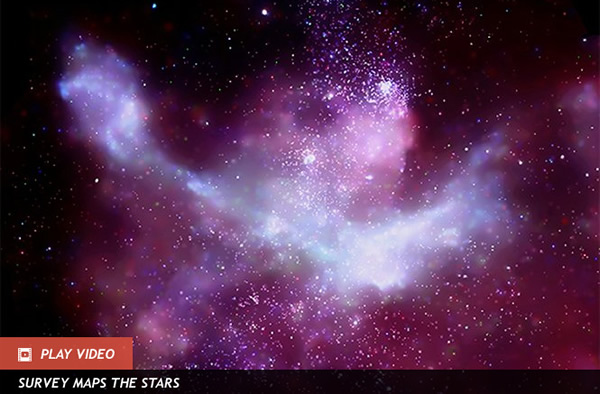Cosmic 'Booze' Created in Quantum Brewery
Cosmic 'Booze' Created in Quantum Brewery
As any home brewing enthusiast knows, creating the perfect beer requires, amongst other things, the perfect temperature to optimize the brewing process. Get this variable wrong and potentially days of hard work have been wasted.
So, looking into deep space, where the ambient temperature hovers a little above absolute zero (-273 degrees Celsius or -459 degrees Fahrenheit), one would think that this would be a very bad place to find a cosmic brewery. But astronomers know that cold interstellar clouds and stellar nurseries are laced with alcohol and an ‘impossible’ molecule that cannot be produced through orthodox chemical reactions.
Where did this “cosmic brew” come from?
In a paper published in the journal Nature Chemistry, Dwayne Heard and colleagues from the University of Leeds think that interstellar alcohol — specifically methanol (not ethanol, the stuff that gets us buzzed) — undergoes a chemical reaction with hydroxyl radicals to produce methoxy radicals. (Radicals are atoms or molecules that are highly reactive with other chemicals.) Methoxy radicals are known to exist in deep space, having been discovered in 2012 by radio telescopes. This presented a quandary; methoxy radicals shouldn’t exist in deep space at all, so some shortcut mechanism must be allowing a reaction between methanol and hydroxyl radicals in extremely low temperatures.
Traditionally, it has been assumed that any complex chemical reaction in interstellar space can only occur in dusty clouds. The dust particles would act as “staging posts” for complex chemicals to condense around; once attached to the dust grains, chemical processes can take place. But in Heard’s lab experiments, when exposed to radiation (simulating the emissions from baby stars in stellar nurseries), methoxy radicals were not produced as a byproduct of methanol and hydroxyl radicals. The dust grain theory therefore couldn’t explain the chemical reactions taking place.
So, in new experiments carried out by the team, gaseous methanol and hydroxyl radicals were allowed to mix at a temperature of -210 degrees Celsius (-346 degrees Fahrenheit), simulating the conditions of mingling gases in a star-forming cloud. It was thought that this situation shouldn’t allow chemical interactions — the electrostatic force between the particles creates a barrier, repelling the molecules from each other. In theory, the two gases will just sit there, molecules bouncing off one another with no chemical reactions taking place.
But Heard’s analog interstellar cloud produced methoxy radicals; the product of an “impossible” chemical reaction! What happened?
Through a quirk of quantum physics, it’s possible for two particles to overcome the electrostatic barrier. The quantum “wave-like” nature of particles allows a small probability that “quantum tunneling” may occur through the electrostatic barrier, an effect that completely surpasses the repulsive electrostatic force. Once the electrostatic barrier is overcome, the strong force (the powerful force that binds the nuclei of atoms) allows the methanol and hydroxyl radicals to bind, thereby facilitating the chemical reaction that creates methoxy radicals.
The scientists uncovered something rather startling: Not only is quantum tunneling between methanol and hydroxyl radicals possible, the reaction rate is very high.
In their publication, the researchers write: “… at temperatures relevant to the interstellar medium, almost every collision between methanol and OH (hydroxyl) would result in a successful reaction to form CH3O (methoxy).” (emphasis added)
Indeed, they find that the reaction rate is 50 times higher in the cold interstellar environment than it is at room temperature. This has led to a significant finding — it would appear that a key methanol-destruction mechanism in the Universe is a consequence of quantum tunneling at very low temperatures.
“Currently, this reaction is not included in astrochemical networks and, given the high abundances of both methanol and OH in star-forming regions, these results indicate that the reaction of OH with methanol may lead to a significant loss of methanol at low temperatures,” they write.
“If our results continue to show a similar increase in the reaction rate at very cold temperatures, then scientists have been severely underestimating the rates of formation and destruction of complex molecules, such as alcohols, in space,” said Heard in a press release.
Quantum tunneling explains how extreme chemical reactions occur in the hot cores of stars, but this is the first time that quantum tunneling has been pegged as the mechanism that allows ‘impossible’ chemical reactions to take place in some of the coldest reaches of the Cosmos.
Publication: “Accelerated chemistry in the reaction between the hydroxyl radical and methanol at interstellar temperatures facilitated by tunnelling,” Robin J. Shannon, Mark A. Blitz, Andrew Goddard & Dwayne E. Heard, Nature Chemistry, 2013. DOI:10.1038/nchem.1692(Jul 1, 2013 02:30 PM ET // by Ian O'Neill)












